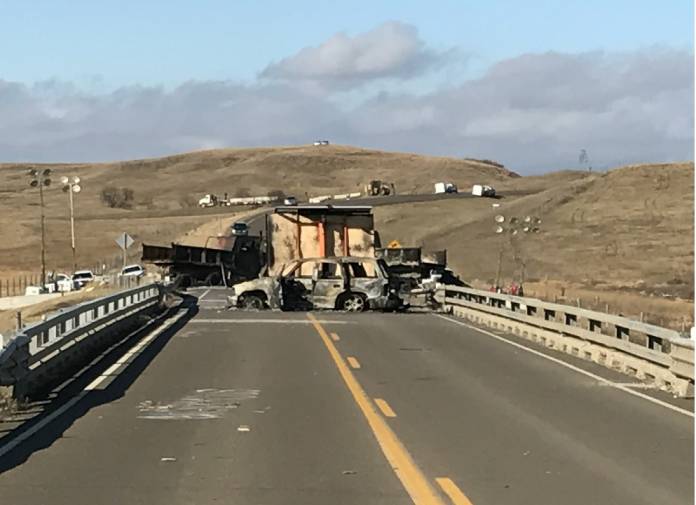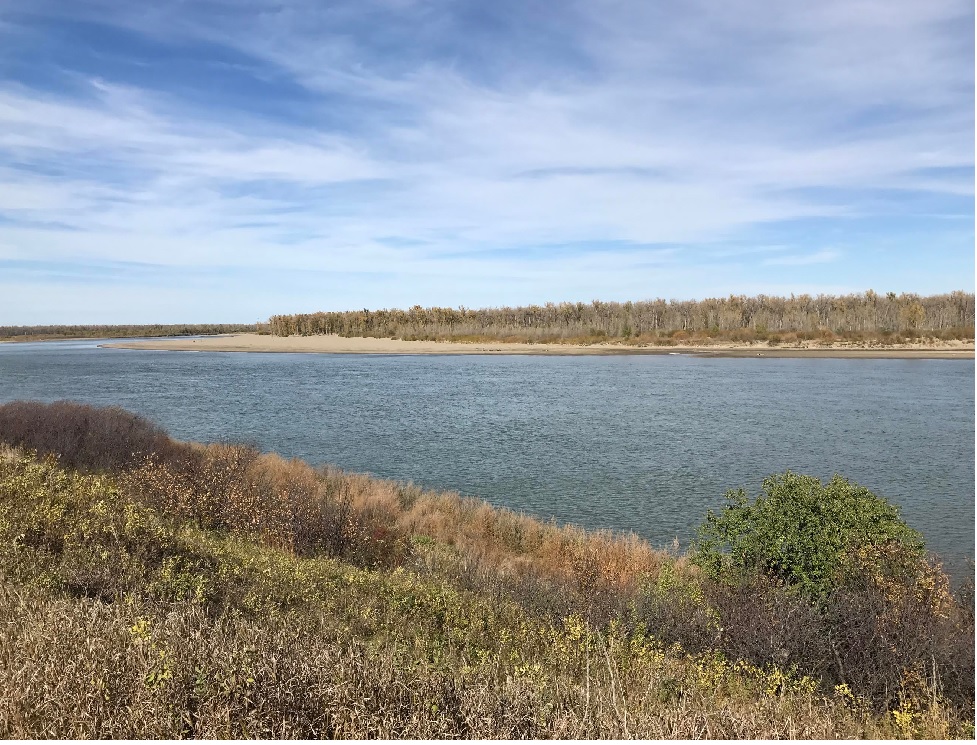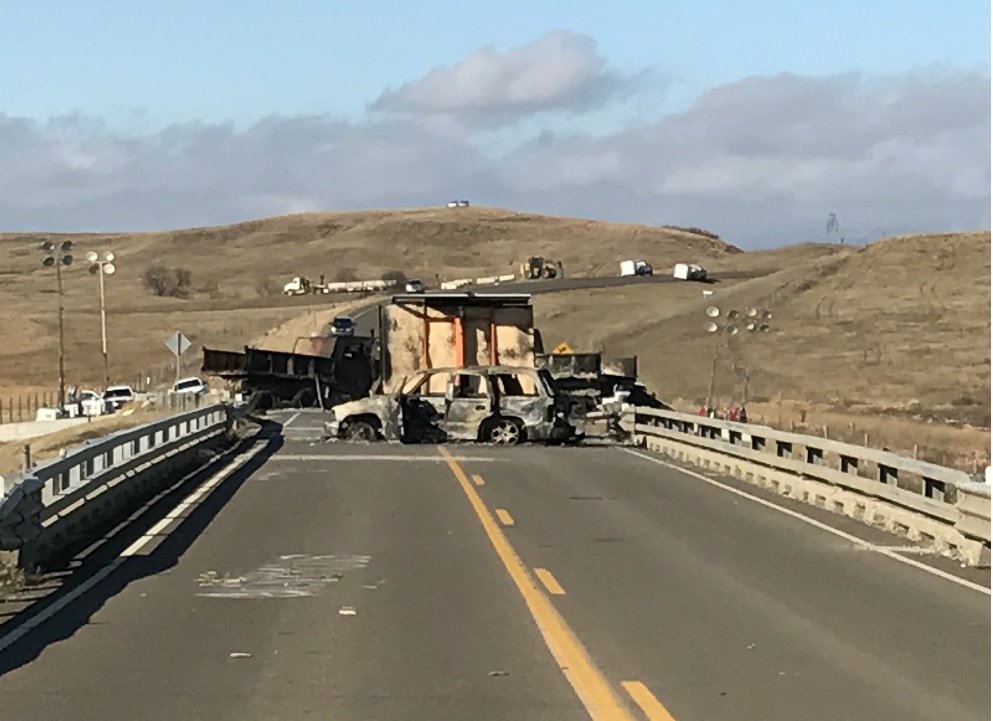
Rose Aguilar is sending daily reports from the pipeline protests at Standing Rock. Read more coverage here.
The drive south from Bismarck, North Dakota to Oceti Sakowin, the main camp at Standing Rock, takes about 40 minutes. It’s a beautiful drive along the Missouri River.

After about 30 minutes on Highway 1806, we were stopped by a National Guard checkpoint and told to turn around and take another route. There’s a huge law enforcement camp near the checkpoint. According to the Indigenous Environmental Network, more than 300 police officers from four states are here.
After police arrested more than100 people and shut down the newly formed frontline camp along the $3.8 billion Dakota Access Pipeline route just east of Highway 1806 on Thursday, they blocked access from where the pipeline is being built from the north and the south. In essence, they’re safeguarding the pipeline with police and military vehicles so construction can continue. The pipeline is in the middle of blockades. Anyone who wants to oppose it no longer has access.

People I’ve interviewed say they believe the state of North Dakota is protecting Energy Transfer Partners, the company that’s constructing DAPL. They also say sacred sites are being bulldozed. From the camp, you can see Humvees on a hill where 11 burial sites are located.
Here’s some background: DAPL will transport up to 570,000 barrels of crude oil per day through North Dakota, South Dakota, Iowa, and on to Patoka, Illinois, the final destination. Altogether, the pipeline will pass through 59 counties.
People here are concerned about the pipeline crossing the Missouri River, which provides drinking water to 18 million people and is the tribe’s main source.
An early proposal called for the pipeline to cross the Missouri River north of Bismarck, the capital of North Dakota, a town that is 90 percent white. According to the Bismarck Tribune, the route was rejected because of a potential threat to Bismarck’s water supply. The pipeline was then rerouted to pass under the Missouri River, at Lake Oahe, right at the doorstep of the Standing Rock Sioux Tribe’s reservation. The pipeline would pass through sacred sites and burial grounds, which are supposed to be protected under federal law.
All of the above deserves far more attention. Many questions remain unanswered. Why was the pipeline rerouted? Who made that decision? If it’s not acceptable to pass through North Bismarck, why is it acceptable to pass just a half-mile upstream from the tribe’s reservation boundary? Journalists need to be asking these questions.
I have left several messages for Energy Transfer Partners, the North Dakota Governor’s office, the Army Corps of Engineers, and the Department of Justice. I have yet to receive any answers.
According to a recent Associated Press report, North Dakota, the nation’s No. 2 oil producer behind Texas, recorded nearly 300 oil pipeline spills in less than two years. None of those spills were reported to the public, officials said.
Most of the pipeline has been completed. According to Earthjustice, the organization that’s providing legal representation to the Standing Rock Sioux Tribe, the Obama Administration still has to make a decision about the easement under Lake Oahe along with other critical permits needed to build this pipeline. As of today, the pipeline is not allowed to be built under the lake—but everyday Dakota Access pushes towards the water’s edge in violation of the government’s request that it stop construction within 20 miles of the easement. Every day the government’s easement decision is delayed, tensions escalate and construction gets closer to the camps.
It’s time to make the decision that the easement should be denied, or, at a minimum, be deferred pending a full environmental review that considers route alternatives. This will allow the situation to de-escalate, and provide a lawful process for completion of the permitting review.”
Native Americans and their allies are incredibly frustrated, but remain determined to protect the Missouri River and sacred sites.
Rose Aguilar is the host of Your Call, a daily call-in show on KALW 91.7 FM in San Francisco. Over the next few days, she’ll be filing daily reports from Standing Rock.


Thank you Rose Aguilar for this excellent report on the plight of these courageous indigenous folk at Standing Rock. DAPL is an example of the exertion of the power with impunity by those who simply can because they’re backed by corporate elite money. There is no regard for common folk either indigenous people or anyone who tries to stand up for the health of the environment. And for Christians this is serious afront to the Creator who made our beautiful lands. Please keep up the reporting. Thank you.
Thanks for this reporting. Nice work Rose Aguilar.
This pipeline threatens more than the Standing Rock reservation, it’s just the Sioux people are the ones that have stood up. It’s incredible this is the same tribe as Little Big Horn and Pine Ridge. They have my respect for what they are accomplishing.
Many other communities will be affected as well. The Missouri River is getting the attention right now, but the pipeline will also cross the Mississippi and Illinois Rivers before landing at a transfer station in the poorest region of Southern Illinois (Marion County is slightly buoyed compared to neighboring counties because of the oil and prison business. I went to college in neighboring Jackson County at SIUC).
Communities all along the pipeline’s path should rise up. Standing Rock deserves better. Patoka, IL deserves better (just google “oil spill Patoka, IL”). The people do have a say in these contracts between the Army Corps of Engineers and these private contractors. But the truth is, the vast majority of people are afraid to stand up in their communities against large contractors. Luckily the Great Sioux Nation doesn’t have this hang-up.